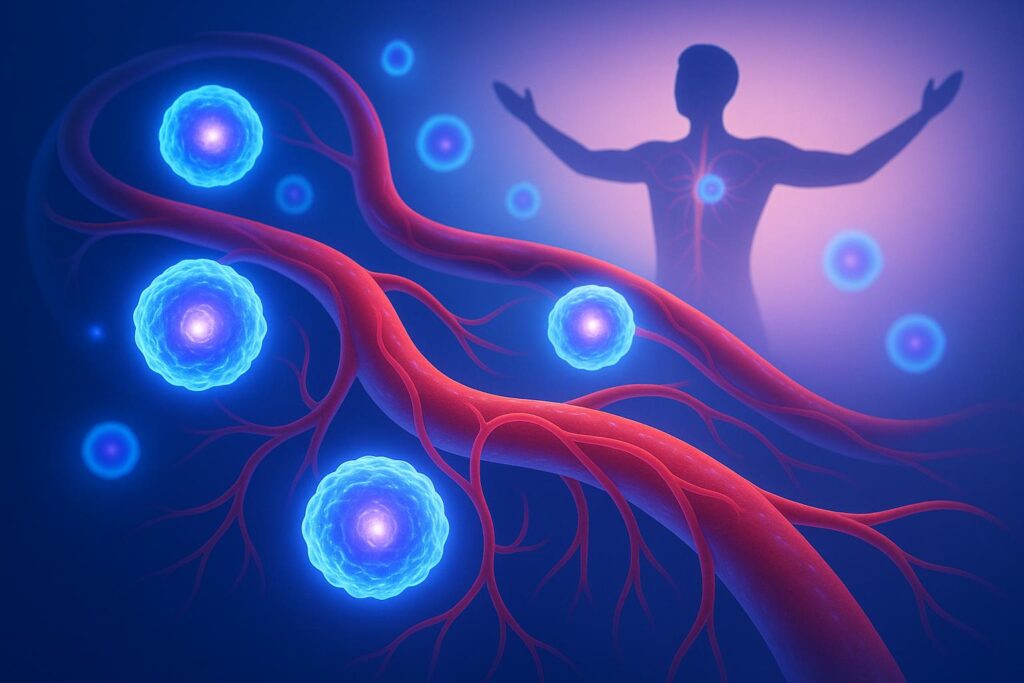Let’s be real. You’re here because you’ve heard whispers about binaural beats potentially kick-starting stem cell regeneration. But you’re probably wondering: does it really work, or is it just another trend getting people excited for nothing?
We get it. The promise of listening to some sounds and seeing health benefits sounds almost too good to be true.
But here’s the good news – there might be some truth to it.
What Are Binaural Beats?
When you play two slightly different frequencies in each ear, your brain picks up on the difference and creates a third, phantom beat. This phantom beat is the “binaural beat,” and it’s what syncs your brain to certain frequencies.
Think of it like tuning a radio. By listening to specific frequencies, you’re tuning your brainwaves, possibly even affecting what’s going on in your body at a cellular level.
Stem cells are the foundation of regenerative medicine. They have the power to differentiate into any tissue and are crucial in bone marrow transplantation and tissue regeneration. The question is, can binaural beats affect these stem cells?
The Science Behind It
Stem cells thrive in an environment that supports their growth and differentiation. The theory behind binaural beats is that certain low frequencies, especially those in the delta range (0.5-4 Hz), could mimic the natural vibrational state of healthy cells. That means:
- You get into a “healing process” vibe.
- Cellular repair is activated.
- You possibly boost your mesenchymal stem cells (MSCs) into action.
The idea is simple: by syncing our brains with these frequencies, we might kick regenerative processes into gear. Previous studies have pointed out that low-frequency waves seem to help with tissue engineering and regeneration.
But, as exciting as all this sounds, let’s put it into context.
So, Does It Work?
We’ve seen some significant effects in preliminary research, but this area still needs much more exploration.
For instance, one experiment showed that MSCs exposed to different frequencies showed improved growth. Researchers have examined the effect of these beats on stem cells, and while some promising signals are there, we need more detailed studies to nail down exactly how effective they are.
Think about it this way:
- Some frequencies could improve the production of growth hormone, which is huge for tissue repair.
- There could be an increase in DHEA, which is known as an anti-aging hormone.
- It may help reduce stress by lowering cortisol levels.
- Increased blood flow and therapeutic effects on overall tissue healing.
We still have a lot to investigate here, but some findings indicate there’s more happening than just a placebo effect.
Can You Use Binaural Beats for Stem Cell Regeneration?
If you want to give it a shot, there are binaural beats out there specifically designed for regeneration and healing. Look for those in the delta range, as that frequency is believed to closely match the brain’s natural repair state.
Therapy sessions using these beats are often recommended for meditation or deep sleep, where your body’s natural healing powers are most active.
But let’s be clear – we’re not talking about magic here.
This isn’t a replacement for proven medical treatments, like bone marrow transplantation for certain conditions, or using regenerative medicine for specific injuries. It’s a supportive measure. It may improve your body’s environment for healing, but it’s not going to rebuild a broken bone overnight.
FAQs: Binaural Beats and Stem Cell Regeneration
1. Do binaural beats really help with stem cell regeneration?
There’s promising research that examined the effect of binaural beats on cellular activity. Early results are intriguing, but more investigation is needed. Think of it as another tool in the wellness toolkit – not a miracle cure.
2. What frequency should I use for stem cell regeneration?
Try low frequency delta waves (0.5-4 Hz). These have been linked to cellular regeneration and could support overall healing processes.
3. Can I use binaural beats along with traditional stem cell therapy?
Absolutely. Binaural beats could potentially boost relaxation and create an optimal healing environment, which might be beneficial alongside conventional stem cell therapies.
Where to Go From Here
We love looking into new approaches that might improve health and regeneration. Binaural beats might be a piece of the puzzle, and it costs nothing to try. Just make sure you’re keeping expectations grounded.
If you’re curious, check out Healthline’s article on binaural beats for a deeper dive into how they work. And if you want the lowdown on what the medical community thinks, WebMD also covers it.
For now, though, it’s worth experimenting – it might just help you feel better, and we think that’s worth it.
At NationalStemCellTherapy.com, we stay on top of every promising lead in stem cell research. Stay tuned, because we’ll keep you posted as more studies come out.



